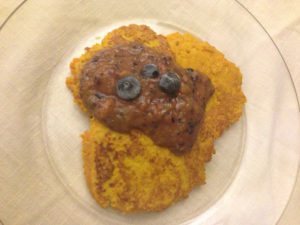 Blueberries are one of the most potent foods in terms of protecting the brain according to Martha Clare Morris, PhD, nutritional epidemiologist at Rush University Medical Center, Chicago. Berries are the only fruit specifically identified in the MIND diet (Mediterranean-Dash Intervention for Neurodegenerative Delay).
Blueberries are one of the most potent foods in terms of protecting the brain according to Martha Clare Morris, PhD, nutritional epidemiologist at Rush University Medical Center, Chicago. Berries are the only fruit specifically identified in the MIND diet (Mediterranean-Dash Intervention for Neurodegenerative Delay).
The diet emphasizes vegetables, berries, fish and healthy fats. The study focused on 923 volunteers from Chicago retirement communities who earned points if they ate brain-healthy foods frequently and avoided unhealthy foods. The March 2015 Journal of the American Alzheimer’s Association reported the diet lowered the risk of Alzheimer’s Disease (AD) when the diet was adhered to rigorously.
Since no one wants the devastating toll AD causes on cognitive function, blueberries have become brain food ever since a preliminary study of daily consumption of wild blueberry juice in 9 older adults with cognitive issues was published in the Journal of Agricultural and Food Chemistry 2010. Subsequent studies using rats fed a blueberry rich diet for 2 months added more excitement to the blueberry health message.
Ronald Prior, PhD at the USDA found one cup of wild blueberries had more total antioxidant capacity than 20 other fruits (including cranberries, strawberries, plums, raspberries and cultivated blueberries). Wild blueberries had the highest total phenolic content among the 25 fruits and vegetables reported by Rui Hi Lui in the Journal of Food Science 2013. Phenolics are phytochemical compounds in plants that protect them from climate insults and pests so they can grow and reproduce.
The USDA Database for Flavonoid Content of Selected Foods 2014 shows the difference between choosing wild vs cultivated blueberries. Wild blueberries (lowbush variety) are smaller and have more antioxidant power with intense flavor. Cultivated (highbush variety) blueberries are bigger with less antioxidants like anthocyanin.
Anthocyanins help protect the body against age related disorders like cancer, heart disease, diabetes, and dementia. When the diet does not include enough antioxidants like anthocyanins, free radicals build up in the body and cause oxidative stress which is associated with disease.
High anthocyanin containing foods like blueberries are consumed on faith since there are no immediate short-term benefits that can be felt or tested.
My favorite way of enjoying blueberries- wild or cultivated- is a healthy breakfast of Sweet Potato Pancakes with Blueberry Banana Fruit Sauce. Both of these recipes are low glycemic and are tasty additions to a healthy paleo diet.
Sweet Potato Pancakes
1 large sweet potato, peeled and baked
2 tablespoons finely chopped onion
1 egg
2 tablespoons coconut or whole grain flour
1/4 teaspoon sea salt
Beat together all ingredients until smooth. Heat lightly oiled large skillet or griddle. Spoon batter onto griddle. Cook over medium heat 3-5 minutes per side until golden brown (do not turn too soon or pancake will fall apart). Repeat with remaining batter. Makes 6- 3 inch pancakes. Serve warm with fruit sauce.
Calories per pancake 84
Protein 3g
Carbohydrates 12g
Fat 2g
Sodium 129 mcg
Note: Raw sweet potatoes can be used by grinding in food processor before combining with rest of the ingredients and adding 1 additional egg to the batter.
Blueberry Banana Fruit Sauce
1 cup fresh or frozen blueberries
1 ripe banana
1 orange, peeled
1/4 teaspoon ground cinnamon (optional)
Combine all ingredients in blender or food processor. Puree until smooth. Serve over waffles or pancakes. Makes 1 1/2 cups.
Calories per 1/4 cup 48
Protein 1g
Carbohydrates 12g
Fat 0
Sodium 39mcg